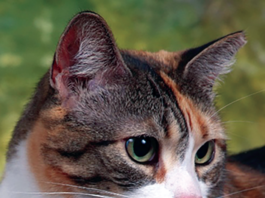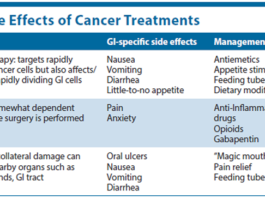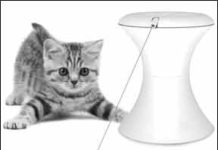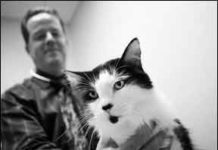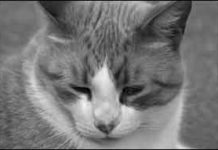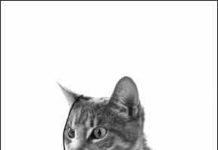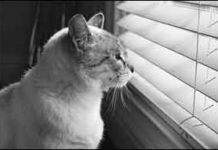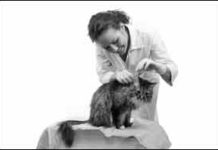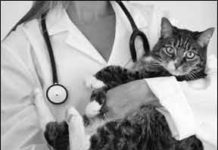Why Do They Chase Lasers Beams?
Cats love to chase lasers’ points of light, twirling, leaping, pouncing. They engage in the behavior with gleeful abandon for one simple reason: “The jumpy, erratic movement of the light beam can stimulate predatory-like play behavior,” says Pamela Perry, DVM, Ph.D., a lecturer in animal behavior at the Cornell University College of Veterinary Medicine.
Slowing Feline Cognitive Decline
Advances in veterinary medicine are keeping our cats alive longer, giving us precious extra years to spend with them. Sadly, extended life-spans also bring geriatric disorders such as feline cognitive dysfunction (FCD), similar to human Alzheimer’s in its symptoms. Like Alzheimer’s, FCD has no cure. And far fewer studies have been done on the feline version of the disease than have been done on the canine variety, so there are no approved medical treatments. But antioxidant supplements, along with mental and physical exercise, often improve the quality of life for both owners and cats.
Robo-Tuffy Provides Hands-on Training
Students honing their emergency skills at the Cornell University College of Veterinary Medicine owe gratitude to a special feline named Fluffy, who doesn’t meow and never needs a litter box. Fluffy is a robotic cat equipped with a mechanical pulse and heart, artificial lungs and electronic hardware and software capable of simulating cardiac arrest, lung diseases, shock and other medical conditions. She and a canine version named Jerry are believed to be the first of their kind used in veterinary schools. Think of Fluffy as a high-tech pet version of the popular battery-operated board game Operation, which tests players’ hand-eye coordination and motor skills.
Protecting Against a Deadly Virus
Young kittens may seem fearless when they demonstrate their acrobatic talents during play, but they’re no match for the potentially deadly disease feline panleukopenia. Sometimes referred to as feline distemper, the disease is caused by the feline panleukopenia virus (FPV). The highly contagious, hard-to-kill virus can spread from infected cats or kittens to other kittens or adult cats who haven’t been vaccinated against it. In addition, recent studies confirm that there has been crossover of the infectivity between cats and newer types of parvovirus usually found in dogs. Parvo Crossover. While some newer canine parvovirus strains can transmit the viral disease to unvaccinated cats, this does not appear to cause disease in most cases, and also does not appear to occur at a rate to cause alarm because the current vaccines used in cats provide protection.
Smart Tactics to Stop Destructive Chewing
Pipper loved to lick plastic and crawled eagerly into every plastic bag she could find. But the longhaired black cat’s fascination with plastic eventually progressed to a big problem — chewing the plastic and ingesting tiny pieces to the alarm of her owner, Pamela Perry, DVM, Ph.D., a lecturer in animal behavior at the Cornell University College of Veterinary Medicine. While some dogs chew sundry objects from shoes to sofa legs, cats tend to focus on houseplants, thread, string, yarn and electrical cords. Some, though, like Pipper, chew plastic, and Dr. Perry reached a turning point with the threat to her cat’s health. Ingested plastic could lead to an intestinal blockage. “I had to make sure that all plastic bags were put away,” she says. “They had to be well-hidden or she would find a way to get them.”
What Happens If You Go First?
Outliving your cat is painful, but it’s the natural order, given the comparatively short feline lifespan. More difficult, and more crucial, to contemplate: What happens if you go first? Preparing for that contingency shouldn’t be done casually. You need to be specific about your wishes to make sure they’re enforceable by law and to back up your plans with money designated for your cat’s care. The good news: Most states now have laws recognizing pet trusts. Quite simply, a pet trust is a legal arrangement that lets you designate assets, such as insurance policies, real estate, cash or a retirement fund, for the care of your cat in the event of your disability or death. You can leave assets only to a living person, says Gregory S. Alexander, J.D., Robert Noll Professor of Law at Cornell University and an internationally renowned expert in property law and theory. As a result, “You have to find someone to receive the legal title to the property [the assets] that you’re going to use to benefit the pet, and you have to find somebody willing to use that property to look after the pet.”
Easing the Discomfort of GI Sufferers
While the cure for inflammatory bowel disease remains elusive, new strides on the nutritional and pharmaceutical fronts are helping affected cats lead healthier lives. The use of novel or hydrolyzed diets coupled with the administration of the synthetic steroid prednisolone seems to offer an effective one-two therapeutic punch for most cats diagnosed with IBD, says Joseph Wakshlag, DVM, Ph.D., Associate Professor of Clinical Nutrition at the Cornell University College of Veterinary Medicine.
Be Ready to Act in a Choking Emergency
Our cats don’t live in a protective bubble, and their feline curiosity can create potential choking hazards. Some cats can start to choke if they gobble large amounts of dry food too quickly or accidentally swallow string. Witnessing your cat in a wide-legged stance, coughing, gasping for breath can be frightening. That’s why it’s vital to know the proper response to keep him safe. “Cats can choke on kibble or toys, but most commonly, they come to the emergency room choking on a foreign object due to chewing on thread or swallowing needles,” says Dan Fletcher, DVM, Ph.D., Assistant Professor of Emergency and Critical Care at the Cornell University College of Veterinary Medicine.
New Options for Separation Anxiety
Collars and diffusers that dispense calming pheromones have become popular among owners eager to ease their catsf separation anxiety. Less generally known but promising new options are supplements and specialized diets. gThe area of veterinary nutraceuticals to treat anxiety is becoming quite active,h says Katherine A. Houpt, VMD, Ph.D., former president of the American College of Veterinary Behaviorists and James Law Professor emeritus of Animal Behavior at the Cornell University College of Veterinary Medicine. gDietary supplements with ingredients like green tea, as well as flower essences like Harmonease, are also now available.h
Enhance His Coat, Improve His Health
A cat’s coat is his glory. Whether it’s soft, thick fur, long flowing hair or the suede-like skin of a hairless breed, the coat is more than an adornment. “The skin and hair buffer the animal from his environment — heat, cold, sun, wind — and make it more difficult for the skin to get infected,” says dermatologist William H. Miller, Jr., VMD, Medical Director of Cornell University’s Animal Hospital. “A dull, dry and unkempt coat doesn’t offer as much protection as a healthy one.” The message is inescapable: Enhance the coat and you enhance your cat’s well-being. The two most important elements to consider are diet and grooming.
The Most Common Neurological Disease
Advances in medications have given veterinarians and cat owners more choices for controlling seizures with fewer side effects. The most commonly used medications are phenobarbital and the newer drugs zonisamide and levetiracetam. “These anti-epileptic medications modify neural transmission in the brain to reduce the number of seizures an animal experiences,” says neurologist Sofia Cerda-Gonzalez, DVM, Assistant Professor of Neurology and Neurosurgery at the Cornell University College of Veterinary Medicine.
When You Want to Adopt a Stray
Your next cat may show up when you least expect it. You glance out the window and see a skinny cat with a dirt-smudged coat looking back at you. He doesn’t rush to greet you like a lovable, lost Labrador Retriever. He sizes you up, determining if you’re friend or foe. You place bowls of food and water on the back porch to prevent him from starving or becoming dehydrated, but as the days pass and the cat moves closer to you and lets you pet him, you’re smitten. You’ve made the transition from performing an act of kindness to wanting to provide a safe, loving home.



